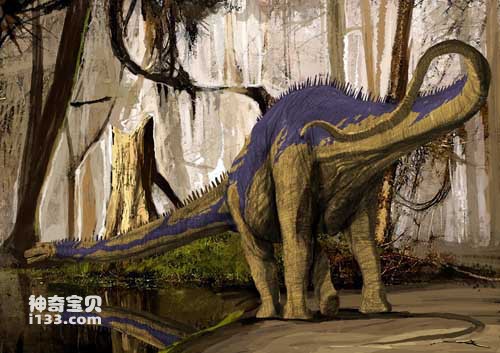Diplodocus lived in the Late Jurassic between 145 million and 155 million years ago. It was a huge herbivorous dinosaur. The body of Diplodocus was very long, with fossils showing that its body was up to 27 meters long even when not fully extended. Diplodocus has an extremely long neck and tail. The neck is 8 meters long and the tail is 14 meters long. So although it is big, its weight is not amazing, usually about 10 to 20 tons.
Diplodocus has a small head, nostrils on the top of its head, and flat teeth in its mouth. It may rarely chew when eating, but swallows pine needles and other food directly. They will select the tender parts of plants. To reduce the digestive burden on the stomach. Diplodocus's front legs were shorter than its hind legs, and its hips were higher than its front shoulders; there were five toes on each foot. It lays many eggs at a time but does not take care of its babies. Young dragons develop very quickly, taking only 10 years to fully develop. A 5-year-old elephant weighs about one ton, but a Diplodocus of the same age weighs 20 tons and is 15 meters long. For young dragons that are not protected by their relatives, fast growth can quickly allow them to reach a size that can compete with predators, increasing their survival rate.
The body of Diplodocus is supported by a series of interconnected central axial bones called vertebrae. Its neck is made up of 15 vertebrae, 10 in its chest and back, and about 70 in its slender tail. It's thought that sauropods' necks were so long so they could extend their heads to the tops of trees (like giraffes), but that's not how Diplodocus used its neck. They extend their necks and sweep out an arc to feed on plants on the ground. Paleontologist Stephen has re-evaluated the eating habits of sauropods. Stephen uses computers to simulate eating movements that cannot be achieved with real bones. He carefully measured each vertebra that made up Diplodocus's neck, then created a computer model to study how the entire neck moved. Stephen found that the way the bones meshed together meant that Diplodocus could not have raised its head too high above horizontal because their necks were not as curved as medieval shepherd's staffs. But they have no trouble raising their heads to the ground (in fact they may reach below horizontal levels). No one had done this kind of research with real bones before, because Diplodocus was too large and heavy to do such experiments.

Chinese name: Diplodocus
Latin name: Diplodocus
Life time: Late Jurassic
Fossil origin: Colorado, Montana, USA
Utah, Wyoming
Physical characteristics: 27 meters long
Diet: plants
Species: Sauropod
Definition: Double-barred lizard
animal tags: Diplodocus
We created this article in conjunction with AI technology, then made sure it was fact-checked and edited by a Animals Top editor.